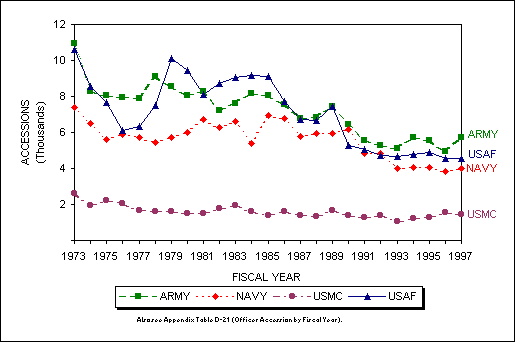|
The commissioned officer corps (with civilian oversight) is the senior leadership and management of the armed
forces. This chapter presents a view of the demographic and social characteristics of both Active Component officer accessions and the commissioned officer corps in FY 1997.(1)
Also highlighted are longitudinal changes among officers. Figure 4.1 illustrates the trend in Active Component officer strength by Service since 1973. Supporting data are provided in Appendix Table D-25.
Figure 4.1. Active Component officer end-strength, by Service, FYs 1973-1997.
These data depict two drawdowns and one buildup in the Active Component officer corps. These changes in military strength can be attributed, at least partially, to changes in
the world situation. The first decline, during the 1973 to 1979 period, can be attributed to the demobilization following the end of the Vietnam conflict; the defense buildup of the
1980s was predicated by the escalation of the "Cold War"; and the most recent drawdown can be attributed to the fall of communism and the end of the "Cold War." At
just over 212,300, the FY 1997 Active Component officer end-strength is 2 percent smaller than in FY 1996 and represents the smallest officer corps in the last 20-plus years.
The number of individuals commissioned by the Services increased 5 percent in FY 1997 to over 15,700 (Figure 4.2). The increases were in the Army and Navy. Officer
accessions in the Air Force remained about the same as the year before. After an increase in FY 1996, the Marine Corps officer accessions decreased slightly, so that the Marine
Corps officer end-strength remained nearly constant.
 |
Figure 4.2. Active Component officer accessions, by Service, FYs 1973-1997.Go to Active Component OfficersGo to Warrant Officers
- Data are for commissioned officers; warrant officers are excluded for the most part. A brief sketch of warrant officers is presented at the end of this chapter.
go back
|

